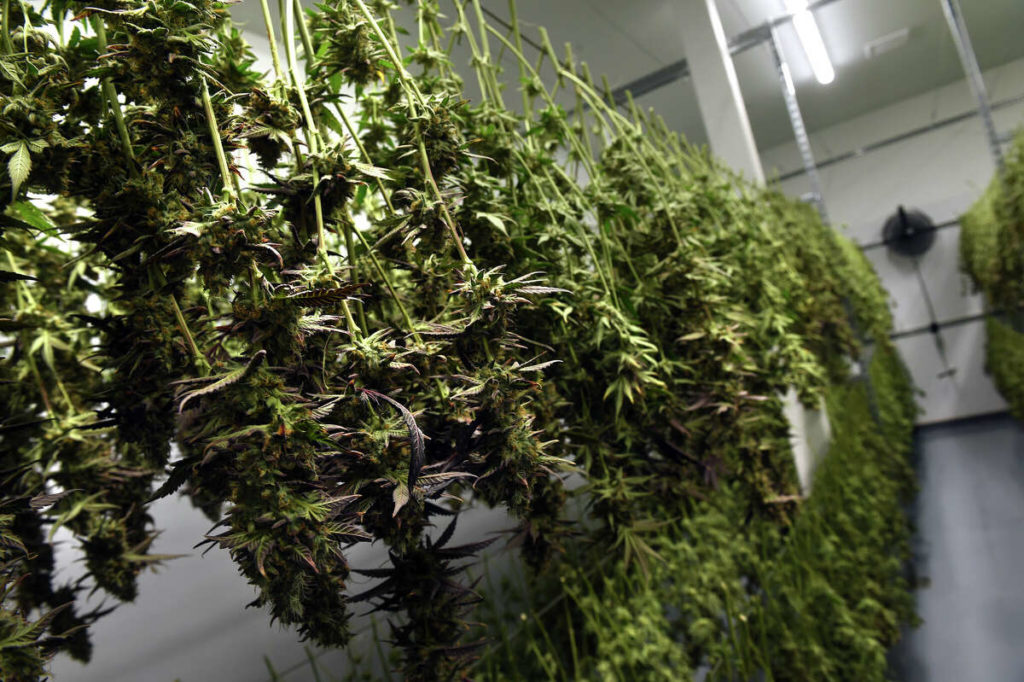Cannabis plants hang in a drying room at the CTPharma cultivation facility in Rocky Hill, Connecticut, on December 13, 2022.
Roughly one-third of chronic pain patients use cannabis to treat their pain, a new study finds. The study, published in the Journal of the American Medical Association, surveyed roughly 2,000 people who experience chronic pain in states with medical cannabis programs, including Connecticut.
While recreational cannabis became legal only recently, with retail sales starting Jan. 10, medical marijuana has been legal in Connecticut for over 10 years.
“Patients are reporting substituting cannabis for pain medications to such a degree that it really underscores the need for research on the benefits of using cannabis for chronic pain,” said Dr. Mark Bicket, study author and professor of anesthesiology at the University of Michigan. “We just don’t know how safe and effective it is.”
The scientific survey reveals high cannabis use among people with chronic pain. One-fifth of chronic pain patients surveyed reported using cannabis recently, within the past 30 days.
Over half of the patients reported that they reduced their intake of over-the-counter and prescription pain medications while using cannabis. The patients also reported using less prescription opioids while using cannabis.
“We really do need to examine cannabis in a more rigorous manner,” said Dr. Bicket. “We need to learn how, and how well, it works for people.”
Dr. Bicket said that he conducted the survey, in part, to get a firmer grasp on how people use cannabis medically. As a pain specialist, he finds it difficult to guide patients who use cannabis, he said.
“For chronic pain, where we’re at with cannabis, it’s still a bit of the Wild West,” he said.
Steven Kinsey, director of UConn’s Center for Advancement in Managing Pain, studies how cannabis affects the experience of pain. He said that while some things are becoming clearer, we are far from understanding how a particular cannabis bud, or strain, clinically impacts pain.
“Despite the plant being used for thousands of years for lots of different things, including pain, depression and digestive ailments, the research is still in its infancy,” Kinsey said.
He explained that while we know several of the main cannabinoids, including THC and CBD, there are also thousands of minor cannabinoids made to different degrees by each strain of cannabis plant. How those cannabinoids interact with the body and what effect various cocktails of cannabinoids have is a topic of active research.
“I think that’s what makes it different from a lot of other drugs,” said Kinsey. “People are ingesting plants, and plants vary. We’re finding that even if a product has the same strain name, it’s not necessarily genetically the same plant with the same chemical makeup.”
Cannabis use for pain and recreation is becoming common enough that anesthesiologists have to take it into consideration when dealing with surgical recovery. The American Society of Regional Anesthesia and Pain Medicine recently released guidelines for dealing with cannabis use in surgical recovery.
“Before surgery, anesthesiologists should ask patients if they use cannabis — whether medicinally or recreationally — and be prepared to possibly change the anesthesia plan or delay the procedure in certain situations,” said Dr. Samer Narouze, ASRA Pain Medicine president. “For example, even though some people use cannabis therapeutically to help relieve pain, studies have shown regular users may have more pain and nausea after surgery, not less, and may need more medications, including opioids, to manage the discomfort.”
Dr. Narouze told CT Insider that the highest-risk patients were those who had recently used high doses of THC, like in recreational cannabis uses. The trouble is that if medical cannabis is too expensive or hard to find that medical users may turn to other sources.
“We’re starting to see that a fraction of patients get the medical cannabis card, and they get it from the street,” said Dr. Narouze. “It’s concerning because you don’t know what they’re getting.”
Uncovering how cannabis works
Cannabis plants produce cannabinoids as part of a suite of anti-herbivore defenses. Mammals also produce cannabinoids as part of cell signaling. In mammals, cannabinoid receptors are found in nerves, the spine and brain. The endocannabinoid system is an important but poorly understood part of how the nervous system functions. Plant cannabinoids interact with this system to create the effects experienced by the users.
“We know there are a lot of subjective effects of THC and potentially other cannabinoids as well that affect perception,” said Kinsey. “We know they have a lot of different effects in the brain.”
Kinsey explained that cannabinoids could be working throughout the nervous system to reduce pain perception by inhibiting the peripheral nervous system’s transmission of pain and the processing of pain signals in the central nervous system. Cannabinoids also have some anti-inflammatory properties, which could reduce pain by reducing inflammation.
He said he was encouraged by the results of Bicket’s study.
“Chronic pain is a big problem. It’s a hard problem that most drugs don’t do a good job of addressing,” said Kinsey. “That’s why people look for something else [like cannabis] if they’re not controlling their pain well.”
Kinsey hopes that studies like this will encourage clinical trials to help understand the efficacy of different cannabinoids for pain management.
H/T: www.newstimes.com



